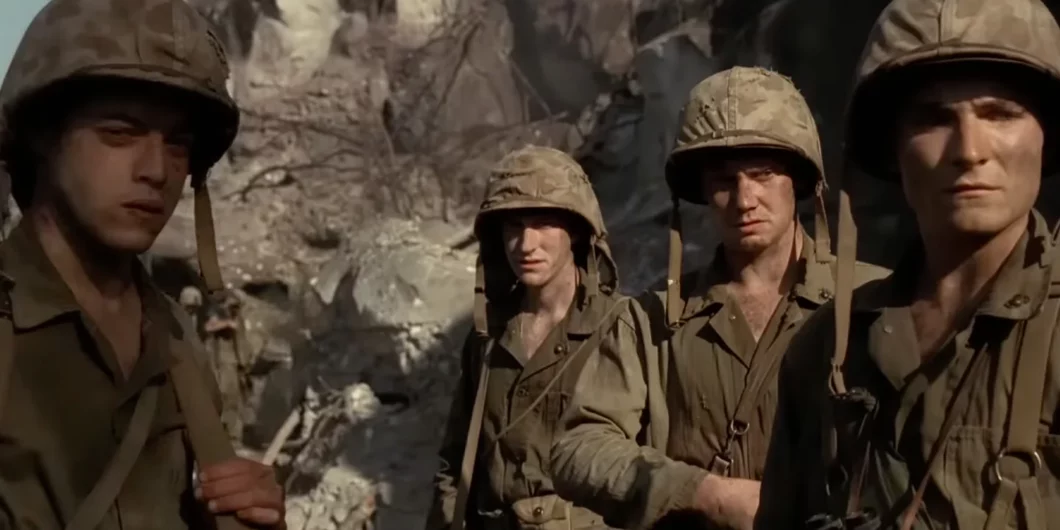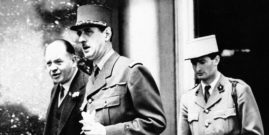The economic policies of the Second World War and our recovery from it present an opportunity for us to see where history rhymes.
The Art of Remembrance
War movies shape public memory—and our remembrance of World War II most of all, since it was the moment America ascended to its current eminence among world powers. The memory we have of WWII, to the extent we have one, is formed by Saving Private Ryan and especially Band of Brothers. Peaceful liberals like Steven Spielberg, the all-American wizard of the end of the twentieth century, and Tom Hanks, who acted as the moral conscience of America, are our guides. We owe them a debt of gratitude for their public spirit.
One strange aspect of the national memory is the almost exclusive focus on Europe and the Nazis. This is in one sense understandable—Germans are much closer and more understandable to Americans than are the Japanese; to say nothing else, the two peoples are connected by Christianity and immigration: Germans were the most populous minority in majority English America. Ultimately, this focus is justified by one important truth, that the world wars were primarily the wars of the European empires, regimes where democratization came through terrible bloodshed.
But America is a sea power and Americans fought and died primarily in the Pacific, so we should consider more attentively that war, where victory required, among other things, the use of nuclear weapons. Consider, too, our current situation: the major economies and military powers of the world are in Asia. India, China, and Japan are far more impressive than France, Germany, and England. More fundamentally, in Asia, America confronts something not previously imagined: technology as modern as anything Americans are proud of inventing, combined with ways of life that seem ancient.
The Pity of War
With these thoughts in mind, let’s turn to The Pacific. I’ve already reviewed Band of Brothers, so it’s useful to compare it to its sequel. They’re both ten-episode series, benefiting from the vast resources of HBO and the ambitions of the storytellers. The source material for the earlier series was the very popular eponymous history by Stephen Ambrose, dedicated to an elite parachute infantry unit, whereas the source for the latter is a very different genre, the memoir: Robert Leckie’s Helmet For My Pillow (1957) and Eugene Sledge’s With the Old Breed at Peleliu And Okinawa (1981), both veterans of the 1st Marine Division, who serve as our protagonists.
Accordingly, the two series can be said to be dedicated respectively to the glory and the pity of war. Band of Brothers aimed to prove that democracy could produce from its own resources heroic men: men tested not by the flattery of celebrity, but by deadly enemies. This is why that series ended with a remarkably generous view of the honor of the German military. The Pacific War, on the other hand, owes its distinctive character to the inhuman cruelty of the Japanese soldiers, their willingness or even eagerness to fight to the death, to the last man—there is no redeeming those men, no way for the Marines, ordinary Americans whose imagination did not include the concept of deaths of honor, to understand them or not to hate them, among other things for feeling compelled to kill them. The Pacific aimed to prove that these democratic men could survive that hell and return to humanity.
The series opens with Leckie in church; as he comes out, he meets a young woman to whom he proposes to write letters from overseas, whom he eventually marries. He’s Irish Catholic. He dominates the first half of the series and, by the midpoint, he loses his faith. He becomes a standard by which we judge the misery of the human condition as revealed by war. In a fictitious scene, he mocks Sledge’s faith and naivety. Sledge dominates the second half of the series; he seems to suffer even more in seeing the horror of war, because he pities his fellow Marines, yet in this way retains his faith. Among the pages of his pocket New Testament, he adds pages of notes, his private journal. On Peleliu, but especially on Okinawa, his experience is something out of Dante’s Inferno. Most of the scenes you will be tempted to think were made up by Hollywood screenwriters for the sake of shock but they are taken directly out of his memoir, including witnessing his fellow marines descend into madness and savagery. Yet both men survive and return to America and civilization, able somehow to put aside the experience of losing almost all their friends.
I believe that when we watch The Pacific and see these characters die, since we know that they were real men, we believe that they died for honor or that they died honorably. Partly, this is because once they are dead, they somehow become the property of the American nation—this is what is meant by the ceremony of wrapping the corpses of soldiers in the flag. We divine somehow that what we all believe in our ordinary lives those men embodied in their agony. This form of political piety is not merely our awareness that we owe them a debt of gratitude, but it is also the belief that they are our true selves.
In order not to be mere propaganda, art must take seriously the men whose activity and suffering are needful for or expressive of that greatness.
The Democratic Experience of War
Along with Leckie and Sledge, who narrated their own experience, The Pacific also offers us a vision of a hero, John Basilone, who received the Medal of Honor for an astonishing nighttime defense at Guadalcanal and who later died on the first day of the assault on Iwo Jima, not before showing his prowess one last time. Leckie and Sledge are patriots, men who identify with America: Pearl Harbor was attacked, so they signed up. Basilone is also a soldier, having signed up and already served in the Philippines before the war. There is no private account of his experience at war and instead, we’d have to turn to official accounts such as the citations for his medals.
Basilone is shown in his moments of daring, but also selling war bonds at a thousand different public events in America once he becomes a national celebrity stateside. As Coriolanus might put it, he is forced to show his wounds to the people who’d never have dared incur them. However, a life of peace is not for him. Although we see him fall in love with a woman in the Marine Reserve and marry, he returns to war to train new Marines, proving that war is also a teacher, and joins them in battle.
Basilone is not the only man to have had this experience, a certain impatience with peace and ordinary life, perhaps even contempt for human weakness, a great desire to return to the war he had barely survived. People see in him the hand of providence, yet he is portrayed as a modest man, loyal to his large Italian family and the men in his unit, and it seems that only the horror of war reveals that he feels the demands of morality more strongly than most people and can live up to those demands when most cannot. The Pacific insists on the shame, guilt, and regrets of the men. But if they were all like Basilone, they would not feel that way anymore, since they would not fall short. Yet, if on the one hand he seems to achieve the impossible in battle, on the other, he again achieves the impossible by maintaining equality with his fellow marines.
Suffering and Art
The Pacific is an impressive series, a rare attempt to depict the island war against the Japanese, the most horrifying thing Americans faced. But it suffers from the typical difficulties of modern art. A few times in the series, the legendary Chesty Puller appears. If the series had followed him, we would have had a story about the Marine Corps as a whole and perhaps the Pacific War as a whole, because he was a great man. But our storytelling has lost that ambition, perhaps because artists, as well as other people, feel they might be betraying democracy if they prefer the great. Individual greatness is thus replaced by national greatness. But this creates a great problem for art. In order not to be mere propaganda, it must take seriously the men whose activity and suffering are needful for or expressive of that greatness, and in that process, it cannot but undermine any political understanding: America won the war, but every individual soldier who died ceased to be part of America. When we wrap soldiers in the flag, we also have to remember what makes them exceptional—without the memorable deeds, memory atrophies.
Further, soldiers have to be relatable to the ordinary man, so that art can connect its audience to everything they haven’t experienced. They thus become less manly and more sensitive on screen. Even the images of their youth become deceptive—men were not soft in our grandfathers’ generation as they are now. There is less of war and more of the staged drama that is supposed to convey their daily experience, because that’s what’s relatable to us. Entire episodes are completely removed from the theater of war; this being HBO, somewhat sentimental love scenes appear in a few episodes, featuring what used to be called tasteful nudity. Although each episode begins with a stylized strategic map of South Asia, most of the audience will understand very little of the war by the end of the show. Perhaps one could say people should learn history in school, but education, as much as art, is greatly diminished once individual greatness is reduced to individual experience.
If you first watch The Pacific and then read the memoirs on which it is based, you will recognize many scenes or details that allude to the writing, but which hardly made sense or meant anything on screen. This allusive style is definitive of the art of our times. It achieves a kind of mastery over the world it depicts by referencing everything and appeals to cleverness in recognizing references without involving knowledge or reflection—instead, the question is the emotional effect elicited, how you feel about a certain event or character. If you know who Chesty Puller was, you might get why he appears; but most people don’t know him. Ultimately, this style is not fitting for history, certainly not for national memory, and thus in the name of democracy, corrupts democracy by making it impossible for us to learn about our past and ourselves. We will need better art, something closer to the histories middle-aged American men like to read, since they are the popular custodians of our history.



